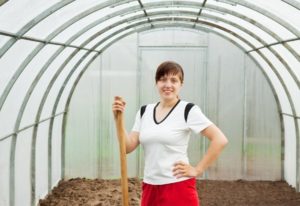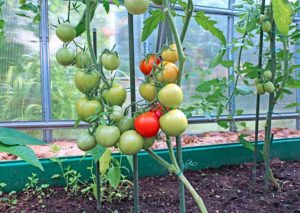We collect greenhouses from arcs
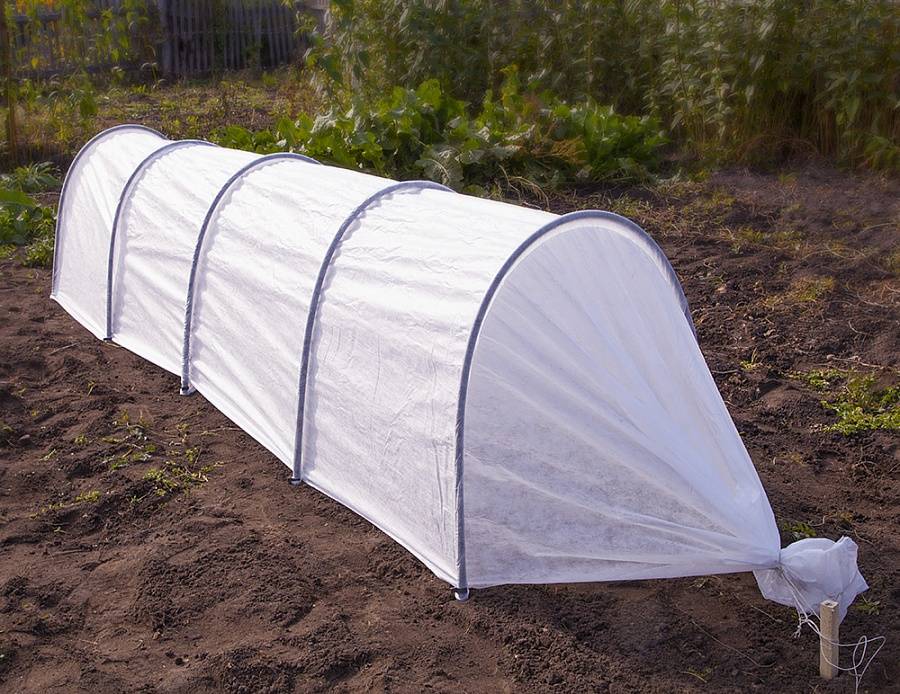
Greenhousescollected from the arcs and canvases of covering material, are widespread in almost all regions of the country. They are lightweight, do not take up much space during storage, at the same time suitable for any crops and show themselves well even in the winter months.
The low price is another advantage of this design. However, you can make it with your own hands, which will allow you to save more.
Greenhouse assignment
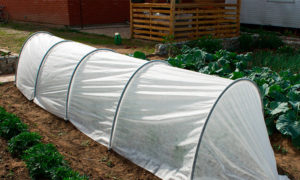
Covering material well holds gusts of cold wind, isolates plants from the settling masses of cold air, helps to maintain a certain temperature and even humidity inside. Therefore, such structures are actively used in order to:
- adaptation of seedlings in spring and early summer;
- protection from pests;
- sprouting seedlings and seeds;
- shelter from birds;
- growing thermophilic crops;
- protection of early varieties when planted in the spring.
Particularly relevant is the construction of a simple greenhouse for lovers of early varieties of tomatoes. This culture is afraid of frosts, which are not rare in spring and even in early summer in most regions. But the first harvest can be obtained at the end of May, if you use a greenhouse or greenhouse. In this case, select extremely low-growing tomatoes. Simple designs of arcs and covering materials are less effective than capital models of polycarbonate or plexiglass, so they can grow crops a little earlier, but you cannot get a full crop in the autumn and especially in the winter months. In addition, it is advisable to choose all the same zoned varieties that are well adapted to a particular climate.
In the small space of such a mini-greenhouse, you can grow both medium and large-fruited varieties. Slightly more difficult to get a big harvest of cherry tomatoes, because the bushes with high levels of ovaries have a significant height.
In the greenhouse from low arcs you can grow a variety of varieties of tomatoes. It is worth planting several small-fruited bushes. They are great for the first workpieces, ripen much earlier and are not susceptible to lung infection. Among these types of worthy crops stand out:
- Abundant Hybrid;
- Friend F1;
- Akulina Hybrid.
The weight of one fruit does not exceed 80 grams, but from one bush it is possible to collect up to 4.5 kilograms. Srednoplodnye tomatoes are more versatile, in this category a huge number of varieties, the height of the bush which is not more than 70 centimeters. They feel good in a limited space, because they do not grow much. The weight of one tomato is about 200 grams, under favorable conditions it is possible to harvest up to 6-8 kilograms of crop from one plant. Recommended for planting in greenhouses from arcs:
- Tourmaline;
- BBW;
- Pink cheeks;
- Jane;
- Boheme F1;
- Volgograd.
Large-fruited varieties in conditions of limited space such a greenhouse will give typical fruits weighing up to 400 grams, however, the total yield will not exceed 6-7 kilograms per bush, while in the open field this figure reaches 9-11 kilograms per plant. You can choose for this planting varieties:
- Peter the First;
- Pelagia;
- Orange elephant;
- Kurnosik.
Close the greenhouse for the winter: step by step instructions
Experienced gardeners are advised to start preparing the greenhouse for the next season immediately after the harvest of the current year ....
Design and dimensions
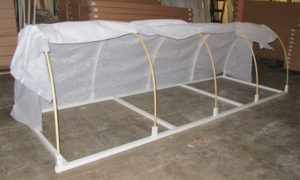
One of the advantages of such a greenhouse - ease of installation. Exact dimensional and complex calculations are not required. In order for the design to perform the main tasks, served several seasons, it is enough to determine the main characteristics. First of all, it is the height of the arcs and their width. The basis should be taken parameters prepared ridges and the height of those plants that will be planted.
The optimum height is one meter. In such a volume, the temperature and humidity are stable, the greenhouse is resistant to winds and snow loads. Height less than 70 centimeters is suitable only for planting greens, radish, germination of seeds. For tomatoes, bell peppers and eggplants you need more space. The recommended width of the greenhouse of the arcs - 1.5 meters. In such a space, you can plant two rows of plants, while there will be enough space for the formation of foliage. Wider plantings are not desirable, since it will not be easy for a gardener to water, loosen, season and fertilize them without fully opening the greenhouse.
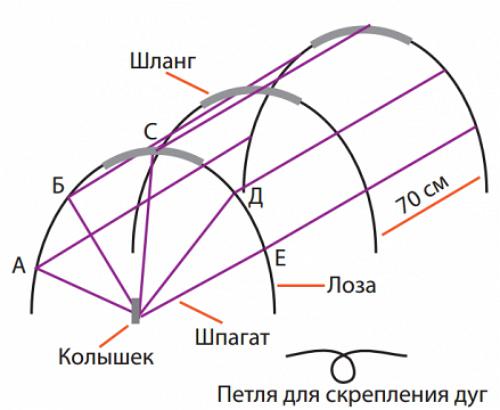
It is permissible to install several arc greenhouses "wall to wall", however, it is necessary to provide for opening them in different directions for maintenance and care of the plants.
Determining the length of the arc greenhouse, you need to focus on the size of 0.5 meters between the arcs. Their more frequent location is not recommended, as this may inhibit plant growth, and the final cost of the design will be too high. Longer gaps without support can sag over time, tearing under the influence of strong winds and even snow masses. For a greenhouse to be stable, it is necessary to correctly calculate the total arc length for the greenhouse: add another 0.5 meter to the required height of the structure to determine the optimal length. Such size will allow to deepen well each support.
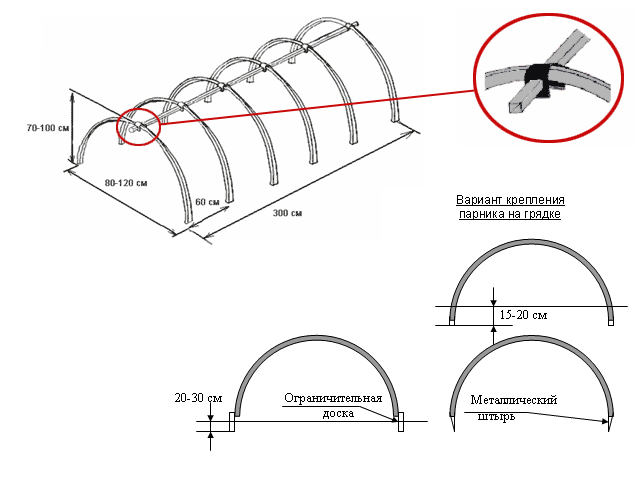
It is important to correctly calculate the parameters of the required covering sheet. The easiest way is to measure with a tape measure the length of the entire support, add to this number 10 percent for fastening and assembling. It should be borne in mind that neither the film nor the geofabric does not stretch, so if you make a mistake in the calculations, you will have to sew the sheets, which will have a negative impact on the durability of the whole greenhouse.
It is also necessary to determine the desired type of construction. The material can be fixed with special snaps to the arcs, this option is simple in execution, but not always convenient in operation. You can sew the base in geofabric and create a folding canvas with supports. In this case, a little more covering material will be required, it is also desirable to provide several “windows”, for example, with zippers, in order not to lift the entire canvas for watering or fertilizing, if necessary.
Tools and materials
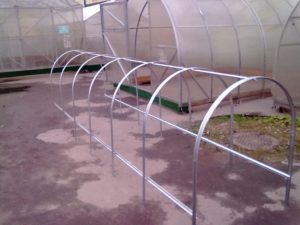
Self-production involves the use of the simplest tools. It should be borne in mind that both film and woven cloths should be cut only with a sharp thin knife, otherwise the most common household appliances will suffice. The most necessary will be:
- construction level;
- roulette;
- fabric knife;
- a knife or scissors for metal;
- construction pencil.
For the simplest construction, only metal arches or supports from any other metal-plastic, covering material will be required. However, to build a strong greenhouse, you must also prepare:
- wooden boards for support;
- fasteners;
- fittings for screed.
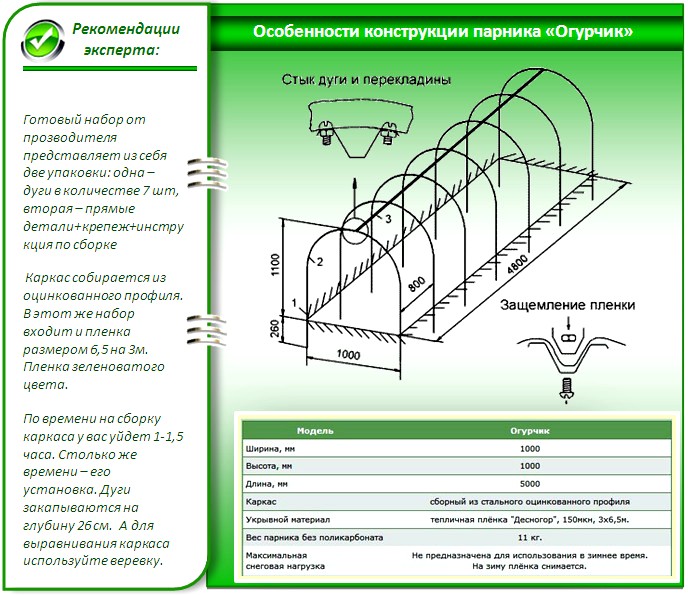
The box or base can be constructed not only from wooden boards, but also from WPC material. It is no less durable.
Assembly technology
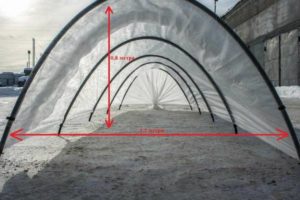
The easiest to assemble and fast version is plastic arches and polyethylene covering material. But such a “structure” will be more durable if you choose metal supports and geofabric.The first stage of the work is the creation of arcs of the desired shape and size. Can be used for these purposes hollow inside bars. It must be cut to a predetermined length, then bent under the influence of heat, for example, welding. However, you can buy ready-made arc, if there is no welding machine.
The next step is to strengthen the base with reinforcement. Take a metal bar with a thickness less than the inner diameter of the main arcs. Stick into the ground at a selected distance from half a meter to a meter to a depth of about 50 centimeters. Arcs to put on the armature, slightly deepening into the ground. Additionally, all can be strengthened with wooden planks. Put them on the butt from the outside against the metal arcs. To fasten with clamps of any diameter.
The next stage is fixing the covering material. Tighten the fabric or film on the arc, securing each with plastic clips. If the diameter of metal pipes is smaller than the size of the attachment, you can put a cloth, it is important to achieve a tight connection. At the two ends of the greenhouse, apply covering material with soil or bricks. If the greenhouse is in the open, it is necessary to protect it from strong gusts of wind. On one side of the wooden base to target the fabric with a furniture gun or nailed with small thin nails.
If the greenhouse is stationary, it is supposed to use it constantly, it should be further strengthened the frame with metal rods from the inside. In the middle of the height of the arc, as well as at the highest point to fix the rod by welding or clamp. It must be ensured that the clamp or seam does not have sharp corners and protrusions that may damage the covering material. Otherwise, the technology of greenhouse assembly remains the same.
Plastic arcs can also be fixed, but only clamps of the same material should be used; metal fasteners can break thin walls.
Metal arc selection
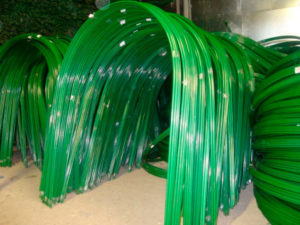
Depending on the budget allocated to the greenhouse, snow and wind loads in a particular region, you can choose one of the many types of material. It is undesirable to use a simple metal rod, since it can quickly penetrate geofabric and polyethylene, even thick enough. The most practical will be:
- wire in PVC film;
- tube section from 10 to 12 millimeters in a PVC sheath;
- galvanized tube.
The last option is the most expensive, so it is rarely used. Such a pipe is good for a stationary greenhouse that will be used for many seasons in a row. Excellent corrosion protection is a major advantage. Thin wire thickness up to 5 millimeters suitable for collapsible mini-greenhouses. PVC will protect the base of the product from rust, but after several installation cycles, the shell peels off, rust begins to eat not only the arcs, but also the fabric itself. Such items need to be changed regularly. The wire is difficult to additionally fasten to the frame, it is better to pass it inside the "pockets" of covering material for durability. A tube with a cross section of 10 millimeters and a PVC coating is the most versatile solution. It is durable, can be used for temporary collapsible shelters or stationary. It is easy to dig it into the ground without foundation in the form of reinforcement. It is for such arcs that standard clips are designed for fastening protective material.
Assembling an arc greenhouse with your own hands is very simple. It is enough to correctly calculate the length of the covering material, plan the location of the arcs and their height depending on the chosen culture. In such a shelter will grow excellent tomatoes of various varieties of the stunted type. Choosing the ways of fixing the greenhouse arcs, it is necessary to take into account the need to transfer the entire structure, climatic conditions.Self-production is a profitable way, since no special tools are required, and materials are available at any hardware store.

